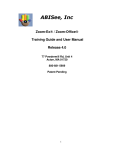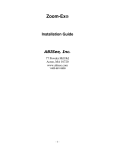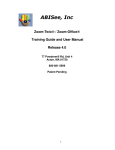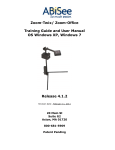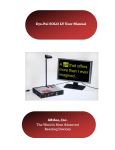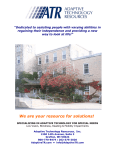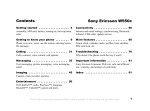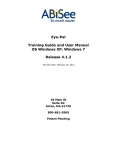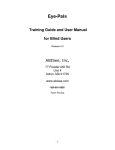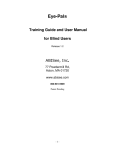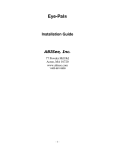Download AbiSee Zoom-Ex User manual
Transcript
ABiSee, Inc. Zoom-Ex / Zoom-Office Training Guide and User Manual Release 4.1 20 Main St., Suite G2 Acton, MA 01720 800-681-5909 Patent Pending 1 TABLE OF CONTENTS: Setting up Zoom-Ex ................................................................................. 4 Quick Start ................................................................................................ 5 How to place a document under the camera .......................................... 5 Do you want Zoom-Ex to talk to you?..................................................... 6 Having your Document Read to You ....................................................... 6 To Read from the beginning of the page .................................................. 6 Page description ...................................................................................... 6 To Read from the Beginning of the Section .............................................. 7 Moving To the Next Word, Sentence, Section, or another Document ....... 7 Viewing Magnified Graphics and Listening to the Voice Reading the Description of the Graphics ...................................................................... 7 Following the text on the screen while listening ........................................ 8 Changing the voice Settings ................................................................... 8 Changing the Language........................................................................... 8 Working in Magnification (CCTV) Mode .................................................. 9 Working in Formatted Text Mode .......................................................... 10 Different Formatted Modes for Following Text on the Screen ............ 10 Other Formatted Mode Options.............................................................. 12 Working in Formatted Text Mode without Speech Output ....................... 12 Switching between Formatted Mode and CCTV Mode ........................ 13 Going to the Next Page or Another Document ..................................... 14 Saving a Document and Opening a Previously Saved Document ...... 14 To Save a Document as a Text File ....................................................... 15 2 To save a Document as a WAV File ....................................................... 16 Opening a WAV file ................................................................................ 17 Printing a Document .............................................................................. 17 Changing Zoom-Ex Display Characteristics ........................................ 17 Changing the sharpness settings ........................................................... 17 Changing the text and background color ................................................ 17 Rotating the view of an object ................................................................ 18 Using the preview window ...................................................................... 18 Changing Advanced Zoom-Ex Display Characteristics....................... 19 Fine tuning the contrast setting .............................................................. 19 Changing the brightness setting ............................................................. 20 Creating and Managing Books .............................................................. 20 Why do I need a Book? .......................................................................... 20 Creating a Book ..................................................................................... 20 Choose How to Scan a Book ................................................................. 22 Scanning modes .................................................................................... 22 Adding Pages to a New Book ................................................................ 23 More Tips on Saving a Book.................................................................. 24 Reading a Saved Book ........................................................................... 25 Managing Books..................................................................................... 26 Adding additional pages to an existing Book .......................................... 26 Deleting pages in an existing Book ........................................................ 27 Deleting a Book...................................................................................... 28 Closing a Book ....................................................................................... 30 Saving a Book as text ............................................................................ 30 Copying a saved Book ........................................................................... 31 Useful Tips for the Zoom-Ex Camera .................................................... 31 Zoom-Ex Quick Reference Guide (4.0).................................................. 32 Reading by word .................................................................................... 32 Reading by character ............................................................................. 32 Reading by sentence ............................................................................. 32 Reading by section ................................................................................ 32 Keypad Keystrokes for Reading Functions. ........................................ 33 Reading by word .................................................................................... 33 Reading by character. ............................................................................ 33 Reading by sentence. ............................................................................ 33 Reading by section. ............................................................................... 34 Zoom-Book Keyboard Command Keys ................................................ 35 Zoom-Book Visual Command Keys ...................................................... 35 ABiSee, Inc. Contact and Customer Service Information ................... 37 What is Zoom-Ex and Zoom-Office? Zoom-Ex is an electronic scanner/reader/magnifier that aids visually-impaired persons in reading printed material and writing in real time. The Zoom-Ex camera is connected to a PC or laptop through a USB 2.0 port. Zoom-Ex weighs about 1lb., making it easy to carry to the classroom. Zoom-Office is a software program that runs on a computer controlling the Zoom-Ex camera. Together, Zoom-Ex and Zoom-Office make reading easy and fun for anyone who has to strain to see that small, fuzzy print. Zoom-Ex can be used to read books, magazines, newspapers, and documents on the computer screen. The reading voice can even be changed For simplicity, we will use the name Zoom-Ex to describe features of both the device and the software. Zoom-Ex is very easy to use. The user places a printed document under the Zoom-Ex camera, and Zoom-Ex displays it on a computer screen instantaneously. There are no buttons on the device. Everything can be controlled using either a keyboard or a mouse. Zoom-Ex works with many languages. Zoom-Ex allows navigating the text for reading off the screen without moving the page, responds to commands instantly, and supports text formatting for easy reading. Zoom-Ex reads text documents aloud with sophisticated, natural language speech synthesizers. No third party software installation required—it‘s included. Zoom-Ex allows you to create Books by capturing multiple pages under one file name. Setting up Zoom-Ex Setting up Zoom-Ex is very easy. Simply plug the USB cable directly into a USB2 port on a computer or laptop. To locate the Zoom-Office application, press the Windows key and the D key will bring up the desktop. Press the Z key to locate Zoom-Office. When you locate the application, open it. Once Zoom-Office opens, it will announce ―Camera started.‖ This indicates that the camera is ready to start scanning. Zoom-Ex runs off a computer‘s power, so there is no need for an additional power source. Quick Start How to place a document under the camera Zoom-Ex should be in the standing position. It has two horizontal legs: the longer leg is 11 ½ inches while the shorter leg is 9 inches long. The two legs create a corner guide to properly align the documents to be scanned. The Zoom-Ex camera captures and saves the 11 inches by 8 1/2 inches page. When the document is placed under the camera, it should be as flat as possible and aligned with the legs. When the camera is turned on, two modes are available: Scanning Mode and Live Magnification (CCTV) Mode. When Zoom-Office starts up, the camera is turned on and it is in Scanning Mode. A full image of the page that is placed under the camera appears on the screen. Zoom-Ex is ready to take an image and read the text. In this Mode, magnification, is not available. In Magnification Live (CCTV) Mode, Zoom-Ex magnifies what is currently placed under the camera, on the computer screen. In this mode, you can fill out forms or look at small objects and pictures under the camera. You can toggle between Scanning and Magnification Modes by pressing the letter ‗Y‘. Place a document under the Zoom-Ex camera and make sure that the camera is in Scanning Mode: 1. To scan and listen to the document under the camera, Press ―E‖. 2. To see your document in Formatted Text Mode, Press ―F‖. 3. To see your Document magnified in Formatted Text Mode, Press ―+‖ to increase the font size. 4. Press ―E‖ to have the text read to you while following the text on the screen. 5. Press F2 to see an image of your document and to increase magnification press ―+.‖ 6. To start using the Zoom-Frog camera, press F7. You will hear ―Zoom-Frog Camera.‖ This indicates that the camera is on. If you press F7, the device will switch to the Zoom-Ex camera. You will hear ―Zoom-Ex Camera.‖ 7. When you are zooming in on distant objects such as the blackboard, the macro lens is not needed. The macro lens is the 1st lens in front of the Zoom-Frog camera that can be adjusted down or up by turning it to the left or right. If you do use the macro lens when zooming in on distant objects they will appear blurry and hard to see. 8. You can only use one camera at a time. Do you want Zoom-Ex to talk to you? When you start Zoom-Ex for the first time, it will work according to the default settings. One of the customizable features is Speech Output. By default, Zoom-Ex will read text and tell you when the camera is on or off, or if your document is placed as portrait or landscape, etc. If you do not want Zoom-Ex to talk to you, go to Applications and down to Settings. In Speech Output, uncheck Status (Zoom-Ex will not inform you about the camera) and/or uncheck Menus and dialogs (it will not read menus and dialogs). Click OK. (See image below) To speak the current control – press Shift. Note: Our application speaks menu bars and dialogs just like the program JAWS, so there is really no need to run JAWS while using Zoom-Ex. Having your Document Read to You To read from the beginning of the page Place the page under the camera, click the space bar to turn the camera on, and press the E key. The Zoom-Ex will read aloud in a few seconds. To stop or pause the voice, press the Control key. To resume the voice, press the X key. To hear and see the text being read, press F2 (F) to change to the Text Formatted Mode. You can also start reading, by going to Voice on the tab menu and down to Speak Entire Page. Page description A page may have text, pictures, graphics, etc. We define sections as page elements or parts of the page that can be easily visually separated from the rest of the page. For example, if the page is a newspaper, than each column will be a section. If the page has a picture in the middle of the page, then the text above the picture is the first section and the text below the picture is the second section. The key combination Shift + E will describe the page layout. It will tell: - the number of words on the page - the number of sections on the page - the percentage of text on the page - the number of columns and headers, if any To read from the beginning of the section Press the Control key plus the Down arrow. You will hear the voice in a few seconds. To stop or pause the voice at any point press the Control key. To resume the voice press the X key. Reading will stop at the end of the section. Moving to the next word, sentence, section, or another document Zoom-Ex allows the reader to move around the page, whether it‘s by word, sentence or section. The following are a few ways to move around the document page: To move to the next word press Control + Right Arrow; To move to the previous word, press Control + Left Arrow. To move to the next sentence, press the Down Arrow. To move to the previous sentence, press the Up Arrow. To move to the next section, press Control + Down Arrow To move to the previous section, press Control + Up Arrow To read at an exact point, place your cursor on a word and press the mouse wheel. Zoom-Ex will start reading at the word your cursor is on. To stop the document being read, press the Control key. Refer to the Quick Reference Guide to find the keystrokes on the keypad for the above reading functions. To read a new page, turn the Zoom-Ex camera on by pressing the space bar. Zoom-Ex will tell you that the camera is now on. Place the new page at the Zoom-Ex base and press the E key. Viewing magnified graphics and listening to the voice reading the description of the graphics The text, which is currently read, does not have to be seen on the screen. You can move the image on the screen to view a picture, graph, etc. and listen to the voice reading the description of the picture at the same time. If there is only one picture on the page, move the picture to the center of the screen, magnify the picture (see Working in Magnification (CCTV) Mode) and click the E key. Following the text on the screen while listening If you want to follow the text while listening, the text must be formatted first. Double click anywhere in the image or click the F key. The formatted text (no pictures, lines ever run of the screen) will be displayed. Magnify the text as desired. You can click the E key to start reading from the beginning of the page. The word that is currently read will be in reversed color. Text will scroll automatically so the word that is read will always be on the screen. See section ―Different formatted modes for following text on the screen‖ for other ways to read formatted text. Changing the Voice Settings You can change the voice parameters by going to Application and go down to Settings then click on the Voice tab: Test different voices, select one and click Apply. You can change the speed by clicking the shift + Q key to make it faster or the shift + Z key to make it slower. You can also change the speed by going to Application down to Settings, over to the Voice tab and using the slide bar. Zoom-Ex can talk in many languages. Select the language you want to read. Changing the Language When you choose Application, Settings andVoice tab, there are two other options that you can modify. The first is OCR Language. OCR Language is the language of the document that you are putting under the ZoomEx camera. By default the OCR Language is English. The second is Application Language. Application Language is the language of the application. This includes text, menus, and dialog boxes. By default the Application Language is English. Working in Magnification (CCTV) Mode Magnify (Zoom-In) and shrink (Zoom-Out) whatever you see on the screen: By keyboard: Press + and – (plus and minus signs) to, respectively, Zoom In and Out By mouse: Roll the mouse wheel forward/backwards to Zoom In/Out. Move the view without moving the magnified document: By keyboard: Press left, right, up or down arrows. (If you are unable to do this see below for further instructions.) By mouse: Click left mouse button at any point on the screen, and move the mouse in the direction you want to move the document. Under Applications, Settings there is a setting called ―Use arrow keys to simulate X-Y table‖ under the General tab. If box is checked arrow keys, will behave as described above, i.e. the user can navigate the screen in CCTV mode with arrow keys. Use the up and down arrow keys to scroll up and down in both the CCTV and formatted mode. If this box is unchecked. the arrow keys can be used for reading functions as described in section ―Notebook (Laptop) keystrokes for reading functions‖. Default value for this setting is unchecked. Working in Formatted Text Mode Formatted Text Mode separates text from pictures and wraps the text according to the selected magnification. Pictures are ―ignored‖, focusing on just the text. The document is scanned and changed over to true font, as in a word document. The text is put in 1 long column and no matter how much you magnify the text it will not run off the screen. There is no need for an X-Y table. Different Formatted Modes for Following Text on the Screen If you go to Applications, Settings, and click on the tab labeled Formatted Mode, four options to read formatted text are featured. The four options are: Full Screen, Highlighted Line, Auto Scroll, and Word by Word. x Full Screen, is it the DEFAULT, and text will be shown on the screen as if it was a word document. This option highlights the word as it is being read. Highlighted Line is one line that crosses the screen and highlights the word as it is being read. Auto Scroll is an option that keeps the text moving in a running line, at a constant speed, across the computer screen. It is controlled by using the (<) and (>) keys. (<) slows down the scrolling text line, while (>) increases the scrolling text line. Auto Scroll is used to read the flowing words across the computer screen, with no highlighting or spoken words. To stop or pause the auto scrolling, press the (X) key. To resume or start auto scrolling, press the (X) key or the (>) key. Note: You cannot use speech output with auto scroll. The Word by Word option puts one word at a time on the screen as it is being read. You have the ability to increase the size of the font seen on the screen by pressing (+) and (-) to decrease the size of the font. You can increase the speed at which the words are being read by pressing (shift + Q) or (shift + Z) to decrease the voice speed. Other Formatted Mode options You have the option to turn on/off the display separation lines between paragraphs as well as true font format. The option display separation lines between paragraphs, if enabled, puts lines on the screen separating paragraphs. If disabled, the text will flow as in a word document. If true font format is enabled, the text will show up on the screen as in a word document. If this option is disabled, the text or font on the screen will show up just as it is in the actual document placed under the camera. Working in Formatted Text Mode without speech output Formatting a document: By keyboard: press F2 (F) key By mouse: double-click anywhere in the text Formatting the text may take a few seconds depending on the amount of text on the page and the power of your computer. Navigating the formatted document in Full Screen Formatted Mode: By keyboard: Use up and down arrow keys to scroll up and down line by line. Use Page-Up and Page-Down keys to scroll up and down page by page. Use Home or End keys to go to the beginning or end of the document. Note: This will only work if “Use arrow keys to stimulate X-Y table” is checked under Settings. Switching Between Formatted Mode and CCTV Mode To go back to Magnification (CCTV) Mode: By keyboard: press F2 (F) key. By mouse: double-click anywhere in the text. After you switch to Magnification (CCTV) Mode from Formatted Mode, Press F4 (S) key in order to adjust sharpness. After switching to Magnification (CCTV) Mode from Formatted Mode, the camera remains off, and the whole page is in the computer memory. Originally, when you switch from Magnification (CCTV) Mode to Formatted Mode, Zoom-Ex will take a snapshot of the page and shut the camera off, in order to format the text. Once you leave Formatted Text Mode and return Magnification (CCTV) Mode, with the camera remaining off, Zoom-Ex displays the still image of the document. It makes no difference as far as reading the document is concerned. However, in order to go to a different document, you have to turn the camera back on. For instructions on how to turn the Zoom-Ex camera on, see Going To The Next Page or Another Document below. Going to the Next Page or Another Document If the camera is on, place the document on the Zoom-Ex base: it will instantly appear magnified on the computer screen if you are working in live Magnification (CCTV) Mode. In Scanning Mode, a full image of the page that is to be scanned is visible. Press „Y‘ to toggle between these two modes. If you are working in Formatted Text Mode, the Zoom-Ex camera is off, and the camera has to be turned on by pressing the space bar. Saving a Document and Opening a Previously Saved Document Place a new document on the Zoom-Ex base. Go to Application and down to Save Image. A Save Image dialog box will appear. Type in the name for your document, and click the Save button. You can save the image of the document while in either CCTV or Formatted Mode. The image will be saved in the default directory ‖My Documents\Zoom-Office\Images‖ or a directory of your choice. To view a previously saved image: Go to Application and go down to Load Image. A Load Image dialog box will appear. Select the image and click Open. The image will appear on the screen in CCTV mode, with the camera turned off. You can manipulate the loaded image exactly as you would the real document, i.e. Format, Read, Magnify, etc. Note : Zoom-Ex does not have to be plugged-in to read previously saved images. To Save a Document as a Text File To save a document as text that is currently under the Zoom-Ex camera, press E to stop the camera. You can then save the document as text. NOTE: Do not use the Space Bar to stop camera unless you are able to see a stable image on the screen. To quickly save text with a default name like ―date/time stamp‖ in the default folder ―My Documents\Zoom-Office\Temp‖, and immediately display the text file on the screen, press Control+Shift+W. You can save text in any directory and give it any name by going to the Application menu and down to Save text then press Enter. A Save text dialog box will appear. Type in the name for your document and click the Save button. Document will be saved in the default directory ―My Documents\ZoomOffice\Texts.‖ You can also select another directory in which to save the document. When saving a ―previously saved‖ image as text there is no need to stop the camera because it is already stopped. Follow the same steps listed above. To Save a Document as a WAV File To save a document as a WAV file that is currently under the Zoom-Ex camera, press E to stop the camera. Once the camera is stopped you can save the document as text. NOTE: Do not use the Space Bar to stop the camera unless you are able to see a stable image on the screen. Once the page has finished being read or you have stop the reading yourself, go to the Application menu and select Save WAV, then press Enter. A Save text dialog box will appear. Type in the name for your document, and click the Save button. The document will be saved in the default directory ‖My Documents\Zoom-Office\WAV‖ .You can also select another directory in which to save the document. Opening a WAV file A WAV or sound file cannot be opened in Zoom-Ex. It has to be opened from the directory where the file was saved. The default directory that WAV files are saved in is ―My Documents\Zoom-Office\WAV‖. Double click on the saved file and it will open in a program such as Windows Media Player. The saved WAV file allows you to hear the full text without having to open the saved image, change it over to text format, then having it read. The saved WAV file also allows you to burn it onto a CD and upload it on to your MP3 player so that you can take your ―Book‖ with you. Printing a Document Zoom-Ex allows you to print out the formatted document with any magnification. To preview the printed document, go to Application and go down to Print Preview. Print the document, or go back to the formatted document and adjust the magnification. Note: Multiple pages may be printed depending on the magnification of one page. The pages can then be read as a book. Changing Zoom-Ex Display Characteristics Changing the sharpness settings Press F4 or S to alternate between sharpness modes. The sharpness/contrast settings should be set separately for the Magnification (CCTV) Mode and the Formatted Text Mode. Changing the text and background color To switch between available colors, press F3 or C. Continue to press C until you have chosen the desired color. In Magnification (CCTV) Mode, the available color options are: - black-on-white - inverted (white-on-black) - color In Formatted Text Mode, the available color options are: - black-on-white - inverted (white-on-black) - green-on-black - yellow-on-black - yellow-on-blue - white-on-blue Rotating the view of an object To rotate a document in the Magnification (CCTV) Mode, press F6 or R on the keyboard. The view rotates 90 degrees each time. The preview window can help determine where to start reading the magnified text. You do not have to turn the document to read it. In addition, orientation of the document on the screen does not matter when text is being read. Using the preview window There are three ways of viewing a page in CCTV mode. Standard magnified mode. The second is a magnified mode with a little picture-in-picture window on the right top corner of the screen. The picture-in-picture window displays the image of the whole page. A focusing rectangle in the preview window identifies an area of the page which is currently displayed on the screen. Full screen preview mode - the preview of the whole page is displayed on the screen. Full screen preview or picture-in-picture preview may be separately disabled in the Preview Window tab of the Settings dialog. Click Application and go down to Settings. The Settings dialog will appear. On the Settings dialog, select the ―Preview Window‖ tab. In the ―Show Preview Window‖ area, select the preview window type that you want to enable (you can select either or both). When camera is ―on‖ only Full Screen Preview can be displayed, unless ―Enable real time zoom‖ checkbox in the Preview tab of the Settings dialog is checked. To show/hide the preview window or alternate between small and full screen preview windows see below: By keyboard: press F5 or V key. The image below shows the full screen preview window enabled; the red focus rectangle is positioned in the center. You can move the red focus rectangle around, to wherever you want to start reading. Once you have moved the red focus rectangle to the desired location, you can either dismiss the preview window (F5), or go directly to formatted mode (F2). The displayed magnified text will start from the portion of the document highlighted by the red focus rectangle. The focus rectangle disappears. The thickness and color of the focus rectangle can be changed via settings dialog. To move the red focus rectangle around the document: By keyboard: By mouse: use keyboard arrows to move the rectangle around. (Make sure X-Y table is checked under the general tab in settings.) left-click the document, to have the red focus rectangle jump there. You can customize how the focus rectangle will look. On the main menu, click Application and go down to Settings. The Settings dialog will appear. On the Settings dialog, select the ―Preview Window‖ tab. You can select focus rectangle color (red, blue or green) and border (thin, medium, thick). Changes made to the preview window do not take effect until you click ―OK‖. Changing Advanced Zoom-Ex Display Characteristics Fine-Tuning the contrast setting To change contrast: Press Ctrl key and „>‟ on the keyboard to increase contrast; press Ctrl key and „<‟ on the keyboard to decrease contrast. Note: make sure Ctrl key is pressed prior to “<” or “>” key. Pressing “<” or “>” keys without pressing the Ctrl key will adjust camera brightness. Changing the brightness setting By default, the camera operates in auto-brightness mode. In order to overwrite autobrightness mode and change brightness: press ‗<‘ on the keyboard to decrease brightness; press ‗>‘ to increase brightness. Note: Brightness can be changed only while camera is ‗on‘, that is, in Magnification (CCTV) Mode. When in Reformatted Text Mode, first switch to Magnification Mode – press space bar, which will re-start the camera. Creating and Managing Books A Book is an electronic copy of a book that you can create using Zoom-Ex. Zoom-Ex allows you to scan and save multi-page documents on a computer. You can view saved books at any computer where a Zoom-Ex device may not be present but Zoom-Office software is installed. While reading a Book you can use all the same document browsing, magnification, and formatting capabilities that are available for viewing documents with Zoom-Ex. You can also listen while the book is read to you page by page. You can save the whole book as text and use any third party software to read the text file. Why do I need a Book? Zoom-Book is convenient if you like having a book at your finger tips. It is a good tool if you are more than likely to read something more than once. A Book allows you to bring your book almost virtually anywhere with you. Just save it to a CD or upload it to your MP3 player. Zoom-Office can be used separately from the Zoom-Ex device, to read saved documents. Creating a Book Have a book or a multi-page document handy for scanning and reading with Zoom-Ex. Place your document under the Zoom-Ex device. Find the Book menu and click on it or (Click Alt-B and then the Enter key). The Create Book dialog will appear: put in the book title and the author‘s name, and click Create. The dialog will go away; the Add Pages bar will appear instead. You can save any kind of book using Zoom-Ex – small paperback books, large books with page size up to 8.5‘x11‘, magazines, etc. Choose How to Scan a Book Start by selecting one of the three Scanning Options: 1. Scan one page at a time. Use this option to scan a small amount of large pages. 2. Scan only odd or only even pages. Use this option to scan a large amount of pages in a large book. Open the book and place the left or right page under the camera. If a portion of the second page also appears under the camera, Zoom-Ex will ignore it. Do not move the book until you have scanned all odd pages you need/want. Once you finished scanning odd pages, do the same for the even pages: Start by turning the book 180 degrees. Be sure that the even pages are now under the camera. The fact that the pages appear upside-down does not matter. Zoom-Ex rotates the pages for you automatically when you want to read the book. - Change the Next Page Number to the first even page number. - Start scanning the even pages When you finished scanning even pages, click the Done button. A Book will sort and keep all pages in the right order automatically 3. Scan two pages at once. Use this option to scan small size books. If you place the open book under the camera and can see both pages in the preview window (F5), you can save both pages at once. While using this option, book orientation is important – always put the book in the landscape format and align the edges of the book with Zoom-Ex base. When you scan two pages at once, both pages will be saved with their respective numbers. When your reading saved pages, you will be able to view each page separately. If the Book failed to separate two pages, it will be indicated by error sound and will save both pages as one page. In this case you can delete that page (See Deleting a Page in a Book section), adjust the book and save the same pages again. Note: The default selection is Scan one page at a time. Scanning modes There are 2 types of scanning modes: 1. Manual Mode In this mode, you press the A key or click the Add button to scan and save the page. You will hear a shutter sound indicating that the page has been scanned and saved. 2. Auto Mode In this mode all you have to do is click the Start Auto Mode button to start scanning/saving pages. Then simply turn the pages. The Zoom-Ex camera has motion detectors so it will scan each page as soon as the page image stays still for a few seconds. It waits while you turn the pages. Auto Mode allows you to use both hands to hold the pages in place, since you don‘t have to operate the mouse or keyboard to push the Add button. Note: The default selection is Manual. Adding Pages to a New Book Now that you‘ve chosen how to scan/save a book, let‘s start adding pages. 1. Manual mode: a) Put the first page of your document under the Zoom-Ex camera: it should appear on screen. b) Click the Add (A) button. Use your hands to keep the book flat. In a second you will hear a shutter sound. The page is now saved, and the Current page field should display 1, while the Next page number should display 2 if you are saving one page at a time or 3 if you are saving two pages at a time, or even (odd) pages. c) Put the next page of your document and click the Add button or press A on the keyboard. d) Save as many pages as you need by repeating the previous step. e) If you are saving a lot of pages, you can always take a break and continue saving pages later. 2. Auto mode: a) Click the Start Auto Mode Button b) Place the open book under the camera; use both hands to flatten the page. In a few seconds you will hear the shutter sound. This lets you know the page has been scanned and saved. c) Turn the page, again keep the page flat and in a few seconds you will hear the same sound. d) Continue turning pages until you have all the pages you need scanned and saved. e) When you are all done or need a break, click the Stop Auto Mode button and remove the book from under the camera. f) When you are completely finished saving pages, click the Done button. Once you have clicked the Done button, the Add Pages book bar will disappear, and the Read Mode book bar will appear. Note: You can add more pages to this book later. See Adding Additional Pages to an Existing Book section of the manual for more details. The Read Mode bar allows you to easily read your saved book with navigation buttons. For more information on reading your book with Read Mode book bar, see Reading a Saved Book topic below. If you are done with your book for now, click the Exit button to close the book. More Tips on Saving a Book 1. Place a piece of white paper under the camera and on the paper. Then Zoom-Ex will not scan the as part of your document. place a book background 2. Make the book as flat as possible. If you are saving a with a lot of pages choose the Auto mode and use both flatten the book. thick book hands to 3. When you are saving a book in Auto mode, Zoom-Ex will automatically adjust brightness to the light conditions at that time. If you are taking a lot of time saving all of the pages, take a break occasionally– click Stop Auto Mode and then click Start Auto Mode – to allow Zoom-Ex to readjust brightness according to the illumination of your room as they may have changed. 4. When you are saving a lot of pages in Auto mode you may notice you have to wait longer to hear the shutter, it could be due to one of three reasons: a. Camera detects some motion – wind, unstable hands, etc.; b. Camera missed a motion when you flip the page; or c. Zoom-Ex turned the camera off because the conditions have changed – for example, somebody turned the lights in the room on or off. It is OK. You can always restart the camera and click the Start Auto Mode button again. 5. If you are using Manual mode be sure that the page is stable on the screen before clicking Add (A) Reading a Saved Book To browse through the saved pages of your document: 1. Go to the Book menu and select Open Book… 2. The Open Book dialog will appear. This dialog will show the books in the default folder My Documents\Zoom -Office\Books. If you want to open the book that was saved in another folder, use the Browse button to select desired folder. The location of the selected folder will be displayed in the Book location field. The list of books in this folder will be displayed on the screen. Note: Make sure you select the folder that contains all your books, and not the folder that bears the name of a specific book. In that folder you might see the folder which bears the name of the specific book – do not select it. 3. Select the book you would like to view, and click the Open button. Note: The Open button is disabled if no book is selected; as soon as you click any book in the list, the Open button will become enabled and clickable. The Open Book dialog box disappears. Read Mode bar appears at the top of the screen; the first page of the chosen document is displayed on screen as well. The reading mode bar has the Previous and Next buttons, along with the Go to page field and Go button to jump to a page out of order. The reading mode bar also has the Current Page field, which displays the number of the page currently being viewed. If the Status parameter box is checked under General Settings, Zoom-Ex will tell you the current page number. 4. You can magnify the image of the current page, format the text part of the image, and use all other functions available for viewing documents with Zoom-Ex to make your reading efficient and more enjoyable. Please read Using Zoom-Ex As a Smart Magnifier and Using Zoom-Ex As The Fastest Reader to learn about the available Zoom-Ex functions. Zoom-Ex will remember all your selections when you move from page to page or from book to book. If you use the Save only odd or only even pages option while saving the book, you will need to rotate only the first even (odd) page. Zoom-Ex will rotate the rest of the page automatically. 5. Click the Next button or letter N on the keyboard to go to the next page of your document; or click the Previous button or you can press P on the keyboard button to go to the previous page. You can also put in a page number out of sequence, and click the Go button to jump to that page. 6. When you are done browsing the book, click the Exit button. Note: When the cursor is on the “Current Page” or “Go To Page” field and you are moving from page to page using Previous (P) or Next (N) buttons, you will hear N or P instead of the “Next” or “Previous”. To avoid this use TAB to move the cursor. Managing Books Adding additional pages to an existing Book To add additional pages to an existing book: 1. Open the book of interest by going to the Book menu and go down to Open Book. 2. Once the Read Mode bar appears, go to the Book menu and select Add Pages. 3. The Add Pages Book bar will appear. 4. Place the page you want to scanned under the camera, set its page number, and press the Add button or the letter A . You can also use the Auto save mode and/or save two pages at a time. See Creating Zoom-Book section for details. 5. Repeat step 4 as needed. 6. When you finish adding new pages, click the Done button. If you were saving pages in Auto mode, click the Stop Auto Mode button first and then click the Done button. The Add Pages book bar will disappear, and the Read Mode book bar will appear again. Deleting pages in an existing Book In order to delete a page in a book: 1. Open the book of interest by going to the Book menu, and click on Open Book. The Read Mode Book bar will appear. 2. Navigate to the page that you want to delete by putting the page number into the Go to page: field and pressing Go. 3.Go to the Book menu, and click on Delete This Page. 4. You will be asked to confirm your instruction. Click yes. 5. The page will be deleted; the display will automatically move to the next page, or to the previous page if the deleted page was the last page of the document. Deleting a Book In order to delete a book: 1. Go to the Book menu, and click on Delete Book. . 2. The Delete Book dialog box will appear. Select the book that you wish to delete and click the Delete button. You cannot delete the open book. 3. You will be asked to confirm your instruction. Click yes. 4. The dialog will be dismissed, and the selected book is deleted. Closing a Book To close a book, you can click the Exit button or go to the Book menu, and click on Close Book. The book will be closed, and the book bar dismissed. Saving a Book as Text After you have scanned the book you can convert the whole book to one text file. Under the Book Menu click on Save Current Book As Text to save the book as text file. The file is saved in the folder My Documents\Zoom-Office\Texts. Depending on the power of your computer it could take approximately from 3 to 6 seconds to save each page. So, for 200 pages the process may take from 10 to 20 minutes. If the Status parameter box is checked under General Settings, Zoom-Ex will tell you the current page number. Copying a saved book The fastest way to initially save a book is to save it on the hard drive. After you have scanned your book, you can use the Save Current Book As menu item to copy the book onto a CD or a memory key. 1. Go to the Book menu, and click on Save Current Book As. 2. Use the Browse button to select the drive and/or folder where you want to copy the book. 3. Enter the New Name for the book. 4. Click the Save button. It may take a few seconds to save the book. You may view and read the copy you made using Zoom-Office software on any IBM compatible computer. Useful Tips for the Zoom-Ex Camera - If you are working with more than one windows application at a time, Zoom-Ex window may lose focus. You know that it has lost its focus if you have tried to turn the camera on or off by pressing the space bar and nothing happens. Click the mouse anywhere on the screen to bring focus to the Zoom-Ex application. - There is a check box under the General tab of the Settings window: ―Use arrow keys to simulate X-Y table‖. The default is unchecked. The unchecked option allows you to use arrow keys while reading the text. For example: to move to the next word, sentence, etc. If you noticed that arrow keys do not behave properly for reading, please, check this setting. Zoom-Ex Quick Reference Guide (4.0) Notebook (Laptop) keystrokes for reading functions. Start/Stop Zoom-Ex Camera: Space or (Caps Lock + Dot). Note: When Zoom-Ex is in Magnification (Live CCTV) mode, press ‗y‘ first, then Space. Start reading: E or (Caps Lock +Down). Stop/Pause/Resume reading: X or (Caps Lock +End). Reading by word: Next: Control + Right or (Caps Lock + Right). Current: Control + I. Previous: Control + Left or (Caps Lock + Left). Reading by character: Next: Right. Current: I. Previous: Left. Reading by sentence: Next: Down. Current: Control + Caps Lock + I. Previous: Up. Reading by section: Next: Control+Down. Current: Caps Lock + Shift + I. Previous: Control+Up. Keypad Keystrokes for Reading Functions Start/Stop Zoom-Ex Camera: Insert + Delete. Switch between Virtual Magnification and Formatted modes: F2 (or F). Switch between Live Magnification and Scanning mode: Y Start reading: Insert + 2. (It will read to the end of page.) Stop/Pause/Resume reading: Insert + 1. Reading by word: Next: Insert + 6. Current: Insert + 5. Previous: Insert + 4. Reading by character. Next: 6. Current: 5. Previous: 4. Reading by sentence. Next: 2. Current: Control + Insert + 5. Previous: 8. Reading by section. Next: Control + 2. Current: Shift + Insert + 5. Previous: Control + 8. Speech output control keystrokes. Increase voice speed: (Shift + Q) or F9. Decrease voice speed: (Shift + Z ) or F8. Hear page description: Shift + E. Hear current control: Shift. Stop speaking current control: Control. Zoom-Book Keyboard Command Keys Add page: A (while creating a new book). Next page: N. Previous page: P. Zoom-Book Menu Accelerator Keys ALT + B is an accelerator for Book Sub-Menu. Key B O D L V A G T Function Book Menu, Create new book. Open Book. Delete Book. Close book. Save current book as. Save current book as text. Add pages. Delete this page. Zoom-Ex Visual Keyboard Command Keys Key Alt Key +/- Function Zoom In/Out. Switch between Preview/Magnification and Formatted modes. Go one screen Up/Down in reformatted mode F2 Page Up/Down F F3 C F4 F5 S V Toggle color. Toggle sharpness. Show/Hide preview panel in magnified mode. F6 R Rotate image 90 degrees. CTRL + SHIFT + S CTRL+L Quick Image Saved Turn LED On / Off. Go to the first line of the page in reformatted mode. Save current image. Home CTRL + S. If option “Use arrow keys to simulate X-Y table” is checked the following keys may be used: In CCTV mode to move magnified portion of the Arrow image Up, Down, Left, Right. keys In reformatted mode go one line Up/Down. </> , / . Brightness adjustment when camera is On When Running line Auto Scrolling Mode is Enabled: </> , /. Speed adjustment ABiSee, Inc. Contact and Customer Service Information Please feel free to contact us regarding any questions or concerns you may have. ABiSee, Inc. 20 Main Street Acton, MA 01720 Phone: 978-635-0202 Toll-free: 800-681-5909 Fax: 253-595-3623 E-mail: [email protected]




































